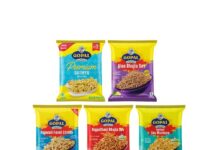The InterFoodTech and Snack & BakeTech fairs in Delhi featured technologies in the food processing and packaging verticals, prominent among which was filling and sealing, or pouching machines, as many would prefer to call it. The technology supplier fairs, aimed at the food & beverage, snacks, bakery, confectionery, and packaging industries, took place from 5 – 7 June 2024 at Yashobhoomi (IICC), Dwarka.

A form fill and seal machine (FFS) forms a package, fills it with a product, and then seals it. It starts with a large roll of film that is formed into the shape of a pouch. The machine fills the pouch with the product and seals it either horizontally or vertically. First, the machine uses a roll of packaging film that is rolled around a core and is typically referred to as rollstock. The film is pulled off the roll by belts and is then transferred to a forming tube. After this process, there is an optional printing step. If needed, most form fill and seal machines will print dates, codes, or graphics on the film.
The forming tube is next, and this is where the film is turned into a bag. Two different types of seals can happen here — a lap seal or a fin seal. The lap seal overlaps the two outer edges of the film to create a flat seal. A fin seal takes the insides of the two outer edges and creates a seal that sticks out. Lap seals usually use fewer materials than fin seals. The film is pulled down through the forming tube and creates the shape of a bag. The bag is then filled and sealed. To simplify the process, the machine hot-seals the bottom part of the film, the product is dispersed into the bag, and the machine finishes with the top seal.

Companies such as UFlex and Shubham Packaging highlighted these machines at the show. UFlex, a one-stop packaging solution provider, showcased its plethora of vertical form-filling and sealing machines for three-side seal (stand-up pouches), multilane and track machines (multiple jobs), and vacuum sealing machines (for hygiene packaging).
Shubham Packaging, a flexible packaging machine manufacturer, showcased both its vertical FFS machine and horizontal FFS machine with a zipper configuration.
According to Shubham Packaging officials, FFS machines see a steady demand even when the flexible packaging market slows down. Demand differs according to requirements for packing single items, powder, or liquid products. “It becomes a packaging of convenience,” said an engineer at the company’s stand giving live demonstrations. He added, “It is easily made and dispatched and so it is convenient for the converter and easy to use and dispose of for the consumers. If there are no additional configurations, it is easily recyclable too.”
HFFS and VFFS
The choice between VFFS and HFFS depends on factors such as the type of product being packaged, desired production speed, space availability, and specific packaging requirements. Both types of machines play critical roles in modern packaging operations, each suited to different applications within the industry.

Horizontal form fill and seal (HFFS), also known as flow wrapping, is perfect for solid items of the same shape and size, which could be anything from biscuits, snack bars, and cakes to leaflets, tissues, toys, accessories, and bundled products. This makes them suitable for industries such as snacks, coffee, pet foods, and pharmaceuticals where diverse products are packaged.
Vertical form fill seal (VFFS) is similar in a way. It is a continuous system for forming, filling, and sealing packaging. However, the process is carried out vertically, with the sealing of one unit causing the formation of the next. As a result, time and material are optimized, as the machinery vertically creates filled and sealed units with minimal waste. This includes items such as bars, cookies, chocolates, and similar products.
HFFS machines create tightly sealed packages around the product, making them suitable for ensuring product freshness and integrity, especially for items that are susceptible to damage or contamination.

VFFS is perfect for sealed sachets and pouches, rather than units with other closures such as zips or nozzles. It can fit the vast majority of budgets due to its cost-effective system. Whereas, HFFS allows a greater variety of packaging types and closures and can be used for packing a wide range of products. It is better for heavier products, as they travel along a conveyor belt.
Steady growth of FFS packaging
According to research by Toopicsco, the FFS packaging market reports indicate a steady growth trajectory, with an estimated annual growth rate of 5.6% from 2024 to 2031. This growth is attributed to the increasing demand for efficient and cost-effective packaging solutions across various industries such as food and beverage, pharmaceuticals, and personal care.

The market conditions suggest a shift towards FFS packaging due to its advantages in terms of improved product protection, extended shelf life, and reduced packaging waste. However, the industry faces challenges such as stringent regulatory requirements, fluctuating raw material costs, and intense competition among key players. Despite these challenges, there are opportunities for market expansion through technological advancements in packaging machinery, advancements in sustainable packaging, and the growing trend toward convenience packaging, the report says.
Overall, the FFS packaging market is poised for significant growth in the coming years, driven by evolving consumer preferences, increasing market penetration, and continuous innovation in packaging technologies. Packaging equipment such as FFS machines put a stop to human errors, inconsistent quality, increasing labor costs, and inefficiency in the process.
IndiFoodBev — authentic, impactful and influential
An English-language food and beverage processing and packaging industry B2B platform in print and web, IndiFoodBev is in its third year of publication. It is said that the Indian food and beverage industries represent approximately US$ 900 billion in revenues which implies more than 20% of the country’s GDP. Eliminating the wastage on the farmside can help to deliver more protein to a higher number of the population apart from generating sizable exports. The savings in soil, seeds, water, fertilizer, energy and ultimately food and nutrition could be the most immense contribution that country is poised to make to the moderation of climate change.
To improve your marketing and grow sales to the food and beverage processing and packaging industry, talk to us. Our research and consulting company IppStar [www.ippstar.org] can assess your potential and addressable markets in light of the competition. We can discuss marketing, communication, and sales strategies for market entry and growth.
Suppliers and service providers with a strategy and budget for targeted marketing can discuss using our hybrid print, web, video, and social media channels to create brand recognition linked to market relevance. Our technical writers are ready to meet you and your customers for content.
The second largest producer of fruit and vegetables in the world is continuously expanding processing capacities and delivery systems with appropriate innovative technologies. We cover product and consumer trends, nutrition, processing, research, equipment and packaging from farm to thali. Get our 2025 media kit and recalibrate your role in this dynamic market. Enhance your visibility and relevance to existing markets and turn potential customers into conversations. Ask for a sample copy of our bi-monthly in print or our weekly IndiFoodBev eZine each Wednesday.
For editorial info@ippgroup.in — for advertisement ads1@ippgroup.in and for subscriptions subscription@ippgroup.in
Naresh Khanna – 10 February 2025
Subscribe Now











